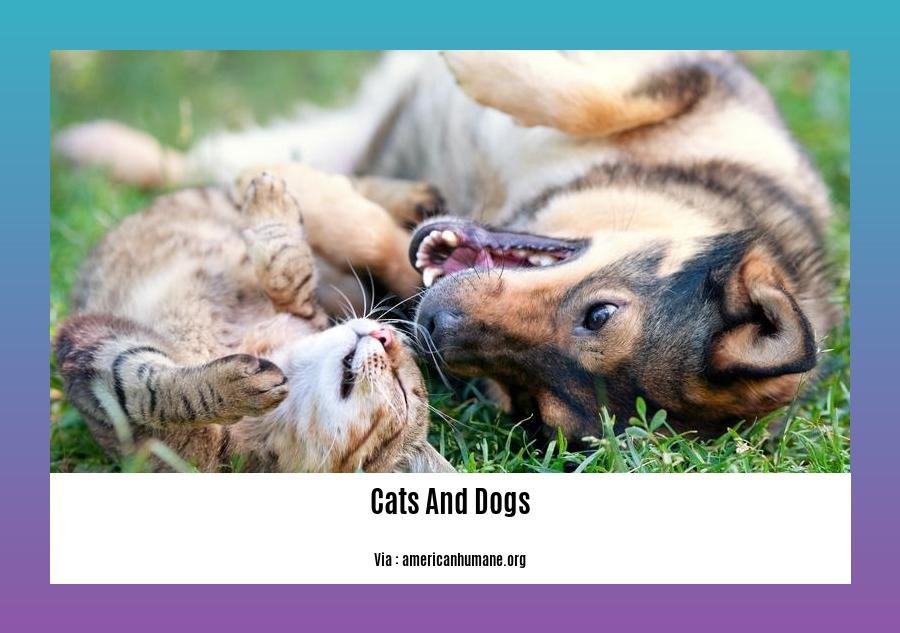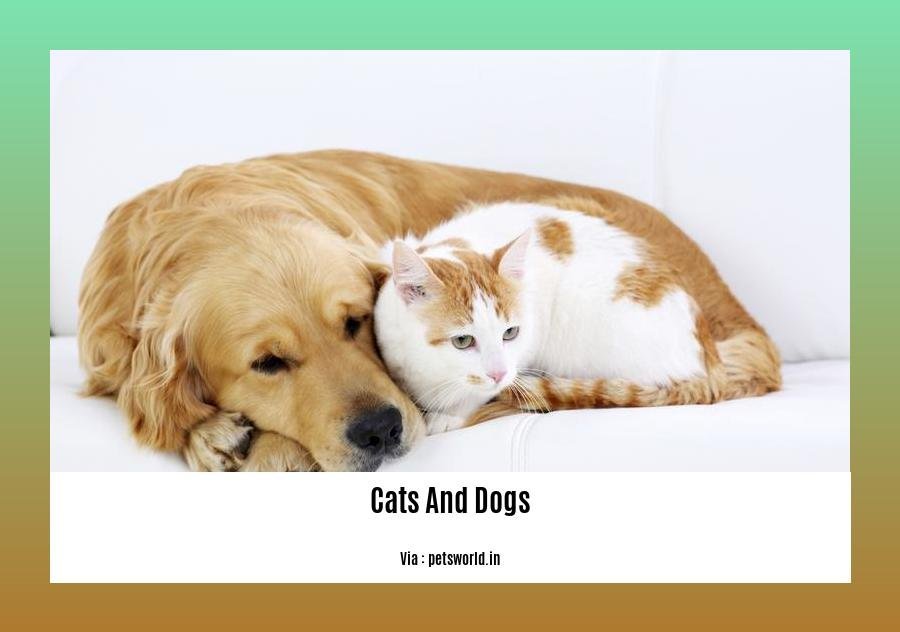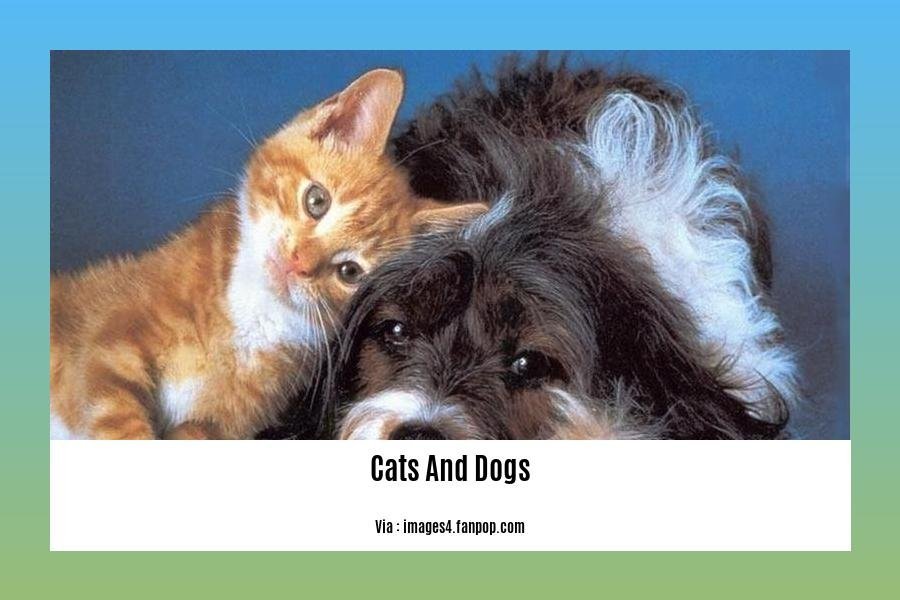If you’re a pet lover seeking to delve into the fascinating world of cats and dogs, you’ve come to the right place. In this article, we will uncover the intricate dynamics and unique characteristics of these beloved furry companions. From their curious behavior patterns to their distinct health tips, we’ll explore the facts about cats and dogs that will undoubtedly leave you enlightened and filled with a deeper appreciation for these wonderful animals.
Key Takeaways:
- Cats have the ability to jump up to 6 times their length.
- Cats cannot see below their nose.
- Dogs have a stronger hearing ability and can hear softer noises than humans.
- The world’s largest dog was a Mastiff named Zorba, weighing 343lbs.
- A group of kittens is called a ‘kindle’.
- The majority of cats are lactose intolerant.
- Dogs have color vision, but they see colors like a color-blind human (shades of grey and do not see blues and reds).
- Cats lose their ability to digest dairy after infancy.
Sources:
[^1^]: Interesting Animal Facts – 140+ Fantastic Facts About Cats and Dogs
[^2^]: Halifax Humane Society – 20 Little Known Facts About Cats and Dogs
Facts About Cats and Dogs: Unveiling the Intricate Dynamics and Unique Characteristics

Cats and dogs, both popular pets, have their own set of fascinating facts that make them truly remarkable creatures. In this article, we will delve into the intriguing world of cats and dogs, exploring their unique characteristics and revealing some astonishing facts. So, get ready to be amazed and gain a deeper understanding of these beloved animals.
Cats: Graceful and Curious Creatures
Fact 1: Cats are masters of agility. Did you know that cats can jump up to six times their length? It’s incredible to think about. Their remarkable jumping abilities allow them to effortlessly navigate their environment, landing with precision and grace.
Fact 2: Cats have some visual limitations. While cats are known for their keen eyesight, they have a blind spot right under their nose. So, if you ever see your feline friend struggling to find something that’s right under their nose, don’t worry—it’s completely normal.
Fact 3: Most cats are lactose intolerant. Despite the image of cats happily lapping up milk in popular media, the truth is that the majority of cats lose their ability to digest dairy after infancy. So, it’s best to avoid giving them milk to prevent any stomach discomfort.
Dogs: Loyal Companions with Super Senses
Fact 1: Dogs have incredible hearing abilities. Dogs can hear much softer noises than humans can. Their acute sense of hearing allows them to detect sounds that would go completely unnoticed by our ears. No wonder they’re often used as search and rescue dogs!
Fact 2: Dogs see the world differently. Dogs experience the world in a unique way. While they can see in color, their color perception is similar to that of a color-blind human. They primarily see shades of grey and do not perceive colors like red and blue.
Fact 3: Guinness world records hold the largest dog ever recorded. Zorba, a Mastiff, holds the record for being the heaviest dog ever recorded. Weighing an astounding 343 pounds, Zorba truly stands out among his canine counterparts.
Comparing Cats and Dogs: Surprising Similarities and Differences
While each species has its own distinct traits, cats and dogs also share some fascinating similarities and differences. Let’s explore them further.
Fact 1: Groupings of kittens and dogs have unique names. A group of kittens is called a “kindle,” which perfectly captures their adorable and playful nature. On the other hand, a group of dogs is commonly referred to as a “pack,” reflecting their social hierarchy and strong bonds.
Fact 2: Cats and dogs have different tolerance levels for dairy. While cats are typically lactose intolerant, dogs can often handle small amounts of dairy without any issues. However, it’s crucial to monitor your dog’s reaction and consult with a veterinarian before incorporating dairy into their diet.
As we’ve unveiled these intriguing facts, it’s clear that cats and dogs possess incredible qualities that make them beloved companions. From cats’ mesmerizing agility and unique visuals to dogs’ exceptional hearing and diverse perception of the world, both species captivate our hearts and bring joy to our lives.
In summary, cats and dogs are truly fascinating creatures. They each have their own remarkable abilities and characteristics that contribute to their overall appeal. Whether you prefer the graceful agility of cats or the loyal companionship of dogs, these incredible animals will continue to enrich our lives with their unwavering love and companionship.
Are you curious about fascinating facts about aquatic animals? Dive into a world of wonder with our collection of intriguing information. Explore more at factsaboutaquaticanimals.com.
Discover the awe-inspiring wonders of aquatic life with mind-boggling facts that will leave you amazed. Learn more at factsaboutaquaticlife.com.
Calling all cat lovers! Do you want to know incredible facts about cats and kittens? Uncover the secrets of our feline friends at factsaboutcatsandkittens.com.
Common Misconceptions about Cats and Dogs

Key Takeaways:
- Some dogs and cats are hypoallergenic.
- Pet hair is not the main cause of allergies in individuals.
- Cats do not always land on their feet.
- Purring does not always mean a cat is happy.
- Tail-wagging in dogs does not always indicate happiness.
- Dogs’ mouths are not cleaner than human mouths.
- Not all cats hate getting wet.
- Dogs can see colors, although differently from humans.
Have you ever heard that certain dogs and cats are hypoallergenic? Or perhaps you believe that pet hair is responsible for causing allergies? In this article, we uncover the truth behind common misconceptions about cats and dogs. Let’s dive in and separate fact from fiction!
Misconception 1: Some dogs and cats are hypoallergenic.
False. Many people believe that certain breeds are completely safe for individuals with allergies, but the term “hypoallergenic” is often misunderstood. The reality is that no breed of dog or cat is truly hypoallergenic. Allergies are triggered by pet dander, saliva, and urine, which are present in all animals to some degree, regardless of their coat type. If you have allergies, it is important to spend time with a specific pet before bringing them into your home to determine if you will have a reaction. [source]
Misconception 2: Pet hair is responsible for causing allergies.
False. While pet hair can carry allergens such as dander, it is not the primary cause of allergies. Proteins found in pet dander, saliva, and urine are the main culprits. These allergens can become airborne and cause reactions when they come into contact with a sensitive individual’s skin or respiratory system. So, it’s not just about the hair! [source]
Misconception 3: Cats always land on their feet.
This is a common misconception. While cats are known for their remarkable ability to land on their feet, it is not always the case. Cats rely on their inner ear and flexible spine to rotate their bodies while falling, allowing them to land on their feet most of the time. However, there are situations where a cat may not have enough time or space to fully rotate, resulting in a less graceful landing. So, not every fall ends in a perfect landing!
Misconception 4: Purring means your cat is happy.
Purring is often associated with a content and relaxed cat, but it can also indicate stress, pain, or discomfort. Cats may purr in situations where they are anxious, frightened, or in pain. Therefore, it is crucial to observe other body language and behavior to accurately interpret a cat’s emotional state. Purring isn’t always a sign of happiness!
Misconception 5: Tail-wagging means that your dog is happy.
Tail-wagging is commonly associated with happiness in dogs, but it is not always the case. Dogs wag their tails for various reasons, including fear, anxiety, aggression, or excitement. To understand what a dog’s tail wagging may indicate, it is essential to consider other body language and the context of the situation. Tail wagging isn’t always a sign of sheer joy!
Misconception 6: Dogs’ mouths are cleaner than human mouths.
This is a myth. Dogs’ mouths contain bacteria, just like human mouths. While the type and amount of bacteria may differ, it is not accurate to say that a dog’s mouth is cleaner or more hygienic than a human’s mouth. It is still important to practice good oral hygiene for dogs, including regular brushing and check-ups with the veterinarian. So, don’t fall for the misconception of a squeaky-clean canine mouth!
Misconception 7: All cats hate getting wet.
False. While many cats may instinctively dislike getting wet, it is not true for all cats. Some cats may enjoy water or tolerate it, especially if they have been exposed to water at an early age. Certain cat breeds, such as the Maine Coon, are even known for their affinity for water. So, not all cats avoid water like the plague!
Misconception 8: Dogs are colorblind.
False. Contrary to popular belief, dogs can see colors, although their vision differs from humans. While they may not see the full range of colors that humans can, dogs can distinguish between various shades and hues. In fact, their vision is more sensitive to movement, which is why they excel at tasks such as tracking and hunting. Dogs have a world with shades, just like we do! [source]
By debunking these common misconceptions about cats and dogs, we ensure that pet owners have accurate knowledge to provide the best care for their furry friends. Remember, it’s essential to separate fact from fiction and understand the unique characteristics and behaviors of these beloved companions.
Sources:
– Pet Keen: 14 Pet Myths and Misconceptions to Stop Believing
– Pet Keen: 18 Biggest Cat Myths & Misconceptions: Get the Facts Straight
Unique Health Considerations for Cats and Dogs
Cats and dogs are beloved pets that bring joy and companionship to countless households. As pet owners, it’s important to understand and address the unique health considerations for these furry friends. In this article, we will delve into some fascinating facts and essential tips to ensure the well-being of your cats and dogs.
Understanding the Intricate Dynamics
Before we explore the health aspects, let’s take a moment to appreciate the intricate dynamics between cats and dogs. These animals may have different behaviors and characteristics, but they both possess unique qualities that endear them to us. Cats are known for their agility, jumping up to six times their length. On the other hand, dogs have an exceptional sense of hearing, allowing them to detect softer noises that humans can’t perceive. These distinct traits contribute to the charm of cats and dogs as beloved companions.
Fascinating Facts
Here are some eye-opening facts about cats and dogs that highlight their individuality:
- Dogs have a unique nose-print, similar to human fingerprints[^1^].
- House cats and tigers share 95% of their genes[^1^].
- 45% of dogs sleep in their owner’s bed[^1^].
- Cats can jump up to six times their height[^1^].
- Dogs’ wet noses help them smell by being coated in a special mucus[^1^].
- Cats have the ability to smell low blood sugar[^2^].
Essential Health Tips
To ensure the health and well-being of your cats and dogs, it’s crucial to follow these valuable tips:
Feeding a Wholesome Diet: Providing a nutritious and balanced diet is essential for maintaining the health of your pets[^3^]. Choose high-quality pet food that meets their specific dietary needs.
Vitamins and Supplements: Consider providing specific vitamins as supplements to enhance the vitality of mature cats and dogs[^3^]. Consult with your veterinarian to determine the right supplements for your pets.
Exercise and Physical Activity: Regular exercise and physical activity are vital for keeping cats and dogs healthy[^3^]. Engage them in playtime and provide opportunities for them to stay active.
Proper Dental Care: Dental care is crucial to prevent periodontal disease in pets[^3^]. Regularly brush your pets’ teeth and schedule dental check-ups with your veterinarian.
Vaccination Considerations: It’s important to limit vaccines to avoid over-vaccination[^3^]. Consult with your veterinarian to develop a vaccination schedule that is appropriate for your pets.
Key Takeaways:
- Cats and dogs have unique qualities that make them cherished companions.
- Dogs have a distinctive nose-print, while cats and tigers share a significant portion of their genes.
- Cats are adept at jumping, and dogs’ wet noses aid their sense of smell.
- A wholesome diet, proper dental care, exercise, and limited vaccination contribute to the overall health and well-being of cats and dogs.
Citations:
[^1^]: “32 little known facts about cats and dogs” by PetsRadar. Available at:
[^2^]: “Facts about Cats and Dogs” by Interesting Animal Facts. Available at:
[^3^]: “10 tips for healthy dogs and cats” by Animal Wellness Magazine. Available at:
Tips for Responsible Pet Ownership for Cats and Dogs
Owning a pet is a wonderful experience, but it also comes with great responsibility. To ensure the health and happiness of your furry friend, it’s crucial to be a responsible pet owner. From choosing the right pet to providing proper care, training, and more, here are some tips to help you become the best pet owner you can be.
Choosing the Right Pet
When considering getting a pet, it’s important to choose one that fits well with your lifestyle, living situation, and personal preferences. Take the time to research different breeds or species to find the perfect match for you. Consider factors such as energy level, space requirements, and grooming needs. Remember, pets should be chosen based on compatibility and your ability to meet their needs for care and attention.
Providing Proper Care
Proper care goes beyond the basics of food, water, and shelter. Regular visits to the veterinarian are essential for your pet’s overall health. Your vet can provide vaccinations, perform check-ups, and address any health concerns. Grooming is also important for your pet’s well-being, as it helps maintain their coat and prevents skin issues. Research potential household hazards and pet-proof your home to ensure your pet’s safety.
Training and Behavior
Training is essential for both cats and dogs to prevent destructive behavior and establish boundaries. Dedicate time to train your pet and use positive reinforcement techniques. If needed, seek professional help from a trainer or behaviorist. Remember, patience and consistency are key when it comes to training your furry friend.
Safety and Identification
Creating a safe environment for your pet is crucial. Secure your home and yard to prevent accidents or injuries. Always keep identification tags on your pet and consider microchipping as an additional safety measure. In case your pet ever gets lost, proper identification increases the chances of a safe return.
Spaying and Neutering
Spaying and neutering your pets is not only important for their own health but also helps control the pet population. It can prevent certain health issues and unwanted litters. Consult with your veterinarian to determine the best time to spay or neuter your pet.
Vaccination and Immunization
Keeping your pet up to date with vaccinations is crucial for their health and well-being. Regular visits to the veterinarian will ensure your pet receives the necessary immunizations to protect them from preventable diseases. Make sure to follow your vet’s recommended vaccination schedule.
Community Involvement and Advocacy
Being a responsible pet owner extends beyond individual care. Get involved in your community and advocate for responsible pet ownership. Consider volunteering at animal shelters, supporting pet-related organizations, and spreading awareness about the importance of responsible pet ownership.
Key Takeaways:
– Choose a pet based on compatibility and your ability to meet their needs.
– Provide proper care, including regular vet visits and grooming.
– Train your pet using positive reinforcement techniques and seek professional help if needed.
– Create a safe environment by pet-proofing your home and using proper identification.
– Spay or neuter your pets to prevent health issues and control the pet population.
– Keep your pet up to date with vaccinations and follow your vet’s recommended immunization schedule.
– Get involved in the community and advocate for responsible pet ownership.
Citations:
– Puppies Club: Responsible Pet Ownership Tips
– PetSafe®: 11 Tips for Being a Responsible Pet Owner
FAQ
Q1: Can cats see in color?
A1: Yes, cats can see in color, although their vision differs from humans. They see colors like a color-blind human, perceiving shades of grey and not being able to see blues and reds.
Q2: Can dogs hear better than humans?
A2: Yes, dogs have a superior sense of hearing compared to humans. They can hear much softer noises than we can, which is why they are often used in tasks such as search and rescue or detecting specific scents.
Q3: Are cats lactose intolerant?
A3: Yes, the majority of cats are lactose intolerant. They lose the ability to digest dairy after infancy, which means that consuming milk or other dairy products can cause digestive issues and discomfort for them.
Q4: Are there any hypoallergenic dogs or cats?
A4: No, there are no truly hypoallergenic breeds of dogs or cats. The term “hypoallergenic” is often misunderstood, but all animals produce pet dander, saliva, and urine, which are common allergens. It is important for individuals with allergies to spend time with a specific pet before bringing them into their home to determine if they will have a reaction.
Q5: Can cats always land on their feet?
A5: While cats are known for their ability to land on their feet, it is not always guaranteed. They rely on their inner ear and flexible spine to rotate their bodies while falling, enabling them to land on their feet most of the time. However, there are situations where a cat may not have enough time or space to fully rotate, resulting in a less graceful landing.















